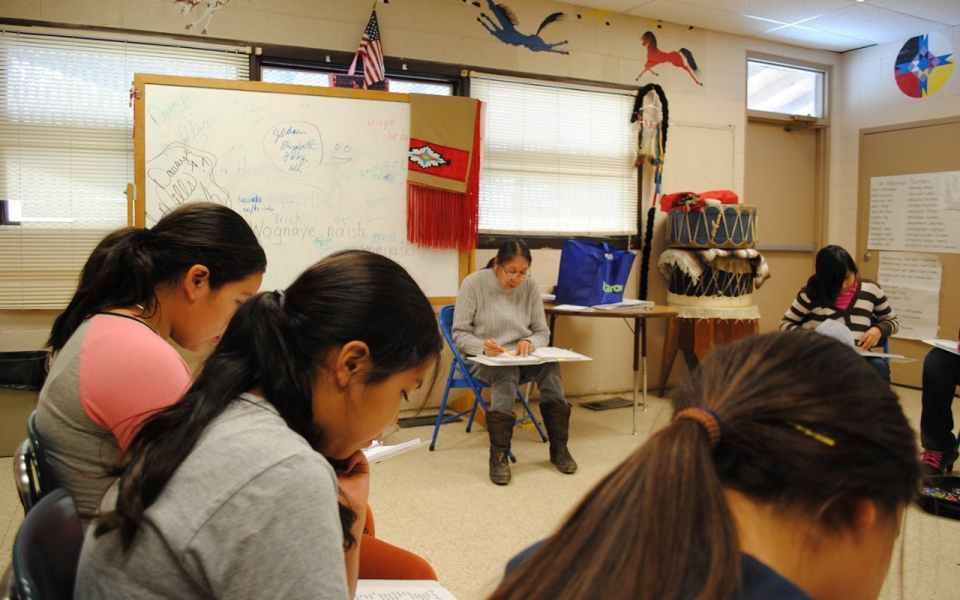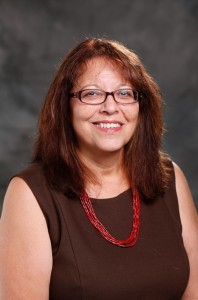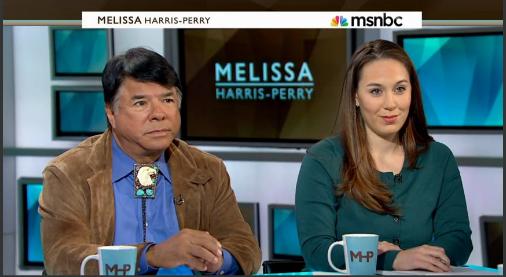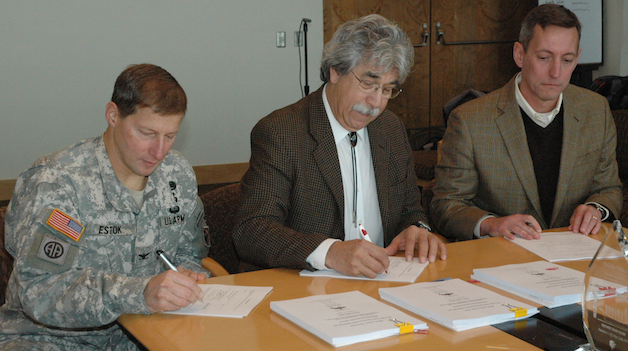Only 6,000 people speak the Lakota language, few of them under 65, but people are working to keep it alive

by Kayla Gahagan @kaylagahagan
December 1, 2013 Aljazeera America
PINE RIDGE INDIAN RESERVATION, S.D. — Dodge tumbleweeds and stray dogs. Venture down a deeply rutted dirt road. Walk into the warmth of a home heated by a wood-burning stove. There’ll be a deer roast marinating on the kitchen counter.
It is here, in a snug home that sits on the edge of nearly 3 million acres of South Dakota prairie, that you’ll find the heart of a culture. It’s here, at the Pine Ridge Indian Reservation, where Joe and Randi Boucher make dinner for their two young daughters. The smaller one squirms and is gently admonished: “Ayustan,” she is told — leave it alone.
It’s here where the Lakota language is spoken, taught and absorbed in day-to-day life.
That makes the Boucher home a rare find. According to the UCLA Language Materials Project, only 6,000 fluent speakers of the Lakota language remain in the world, and few of those are under the age of 65. Of the nearly 30,000 people who live on Pine Ridge, between 5 and 10 percent speak Lakota.
For the past four decades, the race to save the language has started and stuttered, taken on by well-meaning individuals and organizations whose efforts were often snuffed out by lack of funding, community support or organizational issues.
Click to hear Lakota words spoken and explained
Some days, saving the language “seems like an insurmountable challenge,” said Bob Brave Heart, executive vice president of Red Cloud Indian School on the reservation.
The reason, some say, is a number of serious socioeconomic issues that overwhelm the Pine Ridge communities and make it difficult to successfully revive the dying language. The reservation has an 80 percent unemployment rate, and half the residents live below the federal poverty line, making it the second poorest county in the United States. Next to Haiti, it has the lowest life expectancy in the Western Hemisphere. Men live an average of 48 years; women, 52.
But those aren’t hurdles to learning the language, Randi Boucher said. Instead, they should stand as the very reason to perpetuate it.
“It is our language and our life way that will make change,” she said. “We have a loss of self-identity. We’re trying to exist without that. The language, that’s where the healing starts.”
‘Time to do it right’
Language signs at Red Cloud Indian School, which plans to publish the first comprehensive Lakota language K-12 curriculum by the end of this year. Kayla Gahagan
Brave Heart agreed.
“If you lose the language, you lose the culture,” he said. “When students are informed and part of their culture and their language, they have a better sense of self-worth.”
From Joe Boucher’s point of view, they face a much more serious hurdle.
“The biggest enemy we’re battling is apathy,” he said. “Our young people don’t care. They’d rather live in the now.”
They aren’t the only generation resisting the past. Cultural assimilation practices in the U.S. in the 19th century — sometimes in the form of verbal and physical punishment — forced many natives to speak English.
Elders here relive stories of having their mouths washed with soap or their tongues snapped with rubber bands by boarding school staff for speaking their native language.
“We were persecuted; it was dehumanizing,” said high school language teacher Philomine Lakota. “I was completely brainwashed into thinking English was the only way.”
And yet, Brave Heart said, now is the time to move forward.
“We’ve been teaching the language for 40 years, and we’ve been very ineffective,” he said. “It’s time to do it right.”
The school, alongside the American Indian Studies Research Institute at Indiana University, is about to publish the first comprehensive K-12 Lakota language curriculum. The private Catholic school embarked on the project six years ago, developing, testing and revising the curriculum, with the goal to publish by the end of this year.
Starting next year, students will be required to take Lakota language classes through elementary, middle and the first three years of high school. The final year is optional.
“This year’s first graders will be the first group to go through the entire curriculum,” said Melissa Strickland, who serves as the Lakota language project assistant at Red Cloud. She works with the six Lakota language teachers and trains staff across campus to use the language when conversing with the 575-member student body.
An immersion school
The Boucher family lives on the edge of the nearly 3 million acres that make up the reservation. Here, a shelter, constructed with a view of the scenic Badlands, that is used by Native American artists during the summer to create and sell their artwork. Kayla Gahagan
And is it working?
Last year, language test scores at Red Cloud jumped by 84 percent, and this year more than 70 percent of students reported using Lakota at home, in school and in their communities.
Teacher Philomine Lakota is encouraged, but is also aware that many students do not have family members speaking the language at home, and that many will leave the reservation and enter a world where it is not used.
“I realize I will not turn them into fluent speakers,” she said, but her desire is that they become proficient and eventually teach others. “There is hope.”
The $2.2 million project has not been without its hiccups, including personnel changes and disagreements among staff over which materials to use.
“Many programs for language revitalization are immersion,” Brave Heart said. “We’re not. We’re trying to do it within the confines of the educational system.”
Others have taken a road less traveled.
Peter Hill taught Lakota at Red Cloud before embarking on what he calls an exhausting journey to create the reservation’s first successful Lakota language immersion program, one that promises to fill two major gaps for families — language learning and quality, affordable child care.
“Child care out here is horrible. There’s no day care,” he said. “People just kind of get by with family members.”
After months of often unfruitful fundraising and research, the Lakota Language Immersion School opened a year ago with five babies and toddlers, including one of Hill’s daughters.
“At some point, you feel like it’s now or never,” Hill said. “There’s never going to be enough money or the ideal situation.”
The word has since spread, he said, and things are looking up. Today the program has 10 kids and three full-time staff members.
“We literally have kids on a wait list a couple years into the future, for kids not even born yet,” Hill said.
‘Love’ in two languages
The program was almost derailed last month when a severe South Dakota blizzard forced it out of its building. It was given another building in Oglala and recently moved in, but Hill knows the clock is ticking.
“The oldest kids are between 2 and 3 and starting to talk,” he said. “Eventually our feet will get held to the fire. If we say we’re an immersion program, we need to produce fluent kids.”
Finding qualified staff and enforcing 100 percent spoken Lakota remains the biggest hurdle.
“Even fluent speakers aren’t used to avoiding English,” he said. “People aren’t used to speaking Lakota to children. If they were, the language would be in much better shape. It’s a steep learning curve.”
If the language is to survive, the greater movement to save it will have to center on two things, Hill said — kids learning it as a first language and people like himself learning and teaching it as a second language.
Randi and Joe Boucher, who both studied the language in college and learned it from relatives, say they are encouraged by the new efforts.
They speak in Lakota half the time, gently pushing their kids to learn more than names of household objects. They want conversation:
Le aŋpetu kiŋ owayawa ekta takuku uŋspenič’ičhiya he? (Has the dog been fed?)
Wana wakȟaŋyeža kiŋ iyuŋgwičhuŋkhiyiŋ kta iyečheča. (We should put the kids to bed.)
And: thečhiȟila (I love you), a sentiment now mastered by both girls.
Randi is pursuing a master’s degree in language revitalization and hopes to someday open a school focused on a holistic approach to culture and language.
She is expecting another child next summer, and said that even with her aspirations to start a school, the heart of language learning should be in the home.
In their home, their daughters’ traditional native cradleboards — built, sewn and beaded by family — are out on display, a visible reminder of the couple’s insistence on raising their children with ties to their native blood.
“The day we have grandchildren and they can speak to us in Lakota, then we’ll know we did it right,” Randi said. “Then we can die happy.”
Listen to Lakota











